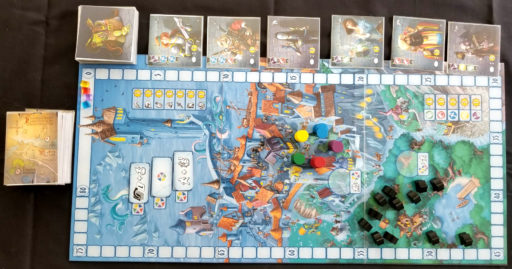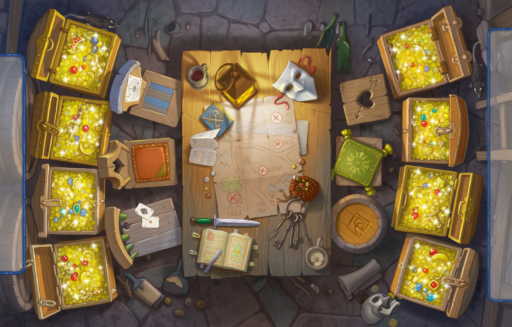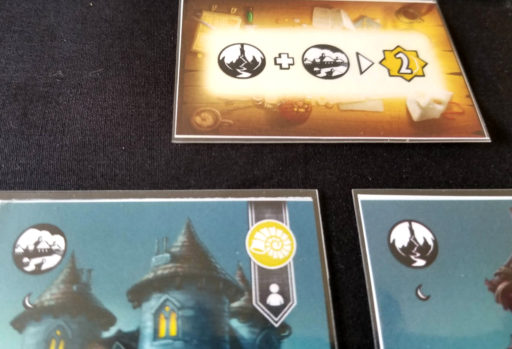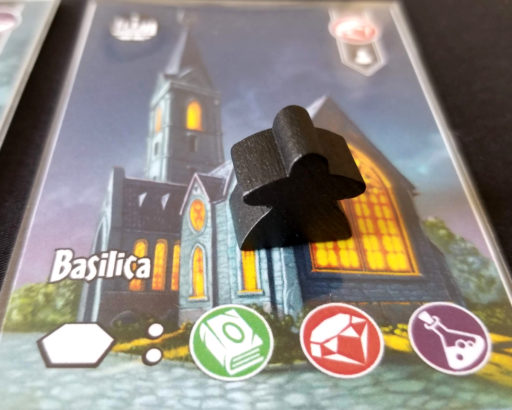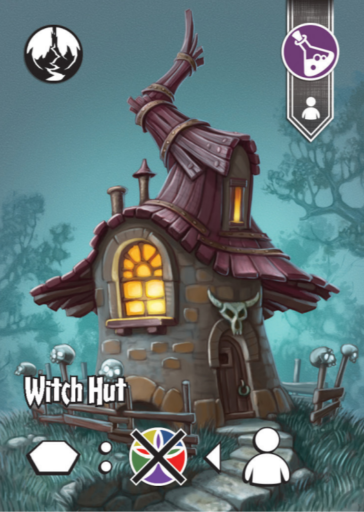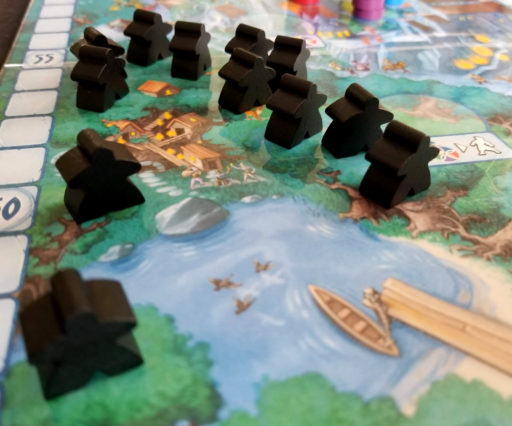They say that crime doesn’t pay. Yet in the world of fiction and pop culture, few crimes are more glamorized than that of The Heist. Second only to perhaps the quest for vengeance, thievery is one of those topics that we intrinsically know is wrong, but in high society settings we collectively take an almost jovial tone to the idea. With smooth-talking leaders, daring escapades full of style and panache, and whole ensembles of co-conspirators in on the job, there is something about the gentleman rogue and the art of stealing valuable stuff that we find so much more willing to embrace than any other major crime.
That is, so long as a) the victim is rich and / or a jerk, and b) no one gets physically harmed in the process. No one wants to champion a gang of people holding up the local Denny’s, but if it’s generic artifacts from an unscrupulous baron? Then not only are we willing to come along for that ride, but we’re routinely put in a position where we’re secretly cheering for the criminals.
Or in the case of Thieves Den, the latest title by Daily Magic Games, getting to be said criminals. Which is ultimately why we’re here today. So get out your lockpicks and make sure your shoes are good and quiet, because the realm is about to experience a robbery spree the likes of which hasn’t been seen in years.
In this lightweight worker placement and set collection game for 2-5 players, each person is a master thief guiding a team of underlings on a series of daring silent raids throughout the city as a means of gaining VP, called Prestige. With the city’s top thief currently incarcerated and enjoying some quality time with the medieval justice system, players spend three rounds trying to build up as much renown within the Larceny League to be crowned the city’s new crime lord. During this time, players must visit various locations (and relieve them of their contents), and then unload those goods before anyone catches wind. In Thieves Den, players are rewarded not only for selling desired goods, but also developing relationships with various middlemen and locations, ensuring that being the next head honcho is more than who has the best sticky fingers.
At the beginning of the game, each player will be provided with their own hideout board, as well as a crew of three junior bandits. Hideouts like this:
Hideouts are your base of operations for laying low and hiding goods, but since you’re not the Big Boss (yet), they are rather discreet. As such, over the course of the game you’re limited to having no more than six hirelings and eight Treasures at any one time.
Treasures make up the heart of your ambitions and payoffs in Thieves Den, and they come in five different classes: Tomes, Jewels, Artifacts, Fossils, and Potions. Aside from their types, however, the only notable difference with Treasures is how easy it is to obtain them, with Potions being the most commonly attained and Tomes the least. Additionally, each player will begin with a secret Scheme card with two Location symbols – reflecting your personal style and preference for pilfering from specific locales. For each pair of those card types you possess at the end of the game, you’ll score additional Prestige.
Thieves Den is played out over three rounds of three phases, each of which works the same way. This ease of gameplay ensures each playthough is easy to grasp and flows well, not leading to any notable areas of confusion or unneeded complexity. The first phase of each round is Scouting, representing you casing which places you’d like to potentially hit up during the round by way of Location cards. During Scouting, players draw four Location cards and then perform a quick draft by selecting one from that hand, revealing and playing it to your tableau, and passing the rest, repeating the process until each player has chosen three Locations.
Every Location serves a twofold purpose. The first is their aforementioned Location type (for Scheming purposes). The second, and more important, is what the Location provides by way of loot, additional recruits, or other special actions. If a Location is revealed with an Instant icon, the player who selected it immediately claims its reward and then adds it to their face-down card pile for the end of the game. Otherwise, Locations must be activated in order to reap the benefits.
Who’d have figured: you actually have to go somewhere in order to steal its contents? Lazy thieves…
Careful selection of which Location cards to choose are key to the game of Thieves Den, as this is were the majority of the activity takes place. Although the game comes with a central board depicting an eye-catching panoramic shot of the kingdom of Amarynth, its functional use is almost superfluous for its size, as it only contains four action spaces of note. Rather, most of the game’s activity involves the Locations themselves. See, regardless of who picked them, every Location card chosen for the round becomes an available action space to consider (i.e. Keyflower style).
Because of this, Thieves Den injects some light strategic thinking when selecting your cards each round as you try to balance between picking Locations that you may want to use yourself and those that may lure in another player’s thieves instead.
Once the Locations are set, the game moves to the aptly-named Thieving phase. Here, players take turn executing one of six different actions. The most common – and enticing – of these actions is Stealing. Stealing requires placing a worker from your hideout onto any unoccupied Location and adding its listed Treasures to your hoard. However, if you visit any other player’s Location but your own, that player receives an ownership bonus from the supply as well.
One can argue these are merely conciliation prizes for other players taking a spot you really wanted, but there can also be instances where you may deliberately put a specific Location out as bait, knowing that you would get the ownership bonus from somebody who couldn’t resist the trinkets you had on display. If anything, they’re better thought of as kickbacks for encroaching on another player’s turf.
For some reason criminals can be highly territorial…
You’ll also want to be mindful of potential underhandedness, as some Locations don’t just provide Treasures but can actively (though infrequently) subvert the inventory of another player. Because sometimes items just wander off, you know? Through this Thieves Den does inject some mild take-that behavior, but it never reaches levels that are widespread or overly punishing. Usually.
But you know what’s missing from all of those popular heist stories once they pull off their immaculate capers and walk off into the sunset? Just what they expect to do with all of that precious loot afterwards. For while you may be able to go on extravagant spending sprees with ill-gotten bags of coins and cash, you can’t exactly walk into your nearby boutique and try to pay with a stolen Renoir or Fabergé Egg. (At a minimum, trying to make change is simply impossible.)
Yet it doesn’t quite do you any good to sit around with them either. All of those fancy stolen goods may certainly jazz up the look of one’s hideout, but if the thrill of the lift is the primary driving force behind professional stealing, making a tidy sum off of your efforts is certainly a close second. That requires finding fences – underworld businesspeople who won’t mind taking hot goods off your hands for a modest sum – with the intent of selling those items off to various buyers at a much higher profit (and trying to get in trouble with the law in their own right).
But hey, that’s their problem.
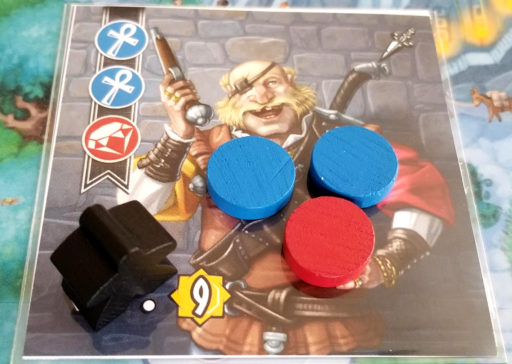
Claimed this Fence card required two Artifacts and a Jewel in exchange for 9 Prestige
(Prototype Shown)
Luckily we don’t have to ponder such things in Thieves Den, because this creative thematic element is not only included, but it’s arguably the most vital action spaces a player can take throughout the game. There are six Fence cards available to players at any given time. Each Fence seeks different combinations of Treasures, providing varying amounts of Prestige as a reward.
To utilize a Fence, you place a worker on that card, claim it, and must provide all of the desired Treasures at once – they don’t want to be dealing with no partial payments, see? Then a new Fence shows up, because there’s always demand for such things.
Fences also come in one of seven different types, and as part of the game’s second endgame set collection bonuses, the player with the most completed Fence cards of each type will be awarded additional Prestige for building up rapport with said individuals. Thus, while gameplay to Thieves Den isn’t super deep, it does afford the opportunity for some calculated decision-making when trying to sell off your goods. There may be times, for instance, when you opt for a slightly less lucrative payoff then to secure some set bonuses later on.
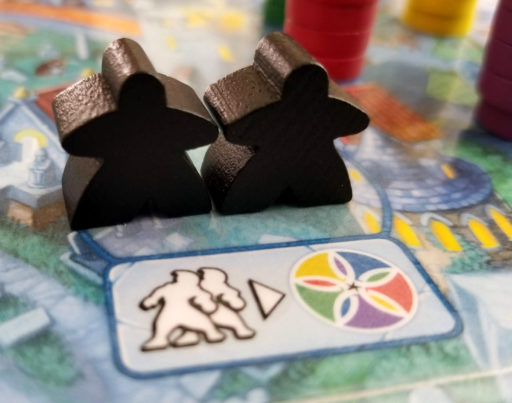
This space allows you to exchange two thieves for a Treasure. Not super efficient but it gets the job done…
(Prototype Shown)
The fact that these Treasures remain ‘locked’ until they’re either used or returned at the end of the round also generates a pleasurable bit of concern and tension over scarcity in Thieves Den. Ensuring that you’ll get the Treasures you desire before stock runs out – or to actually force a dearth in burgle-ready items – will require a bit of prioritizing and timing your actions just right. Resources can get unexpectedly tight sometimes, especially with larger play groups, so don’t dally.
Beyond these two primary actions, you also have the option to utilize one of the game’s four board actions: Burgle Treasure, Recruit a Thief, the three Power Tiles, and the Witch. Burgling allows you to exchange two thief workers for any one Treasure, whereas Recruiting does the opposite: spending two Treasures for a newly minted thief.
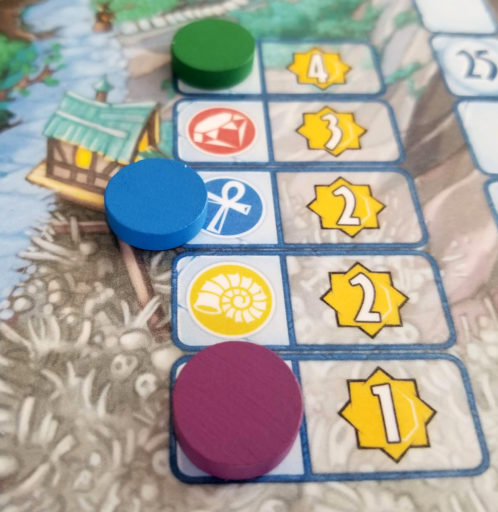
This player provides an Artifact to the Witch for 2 Prestige, locking it out for the remainder of the round
(Prototype Shown)
Likewise, the latter two actions also requires spending Treasures instead of workers. In the case of Power Tiles, you may spend any Treasure on an unused Power Tile space. Each of the three Power Tile provides a unique ability to the game that often shake up normal gameplay slightly. Similarly, the Witch’s house allows a player to deposit a Treasure not already provided that round in exchange for Prestige points.
Once a player can’t or doesn’t want to take any further actions, they pass, ending their actions that round. Once everyone passes, the game moves to a brief Cleanup phase. During this, Power Tiles are replaced and all spent pieces on the board are returned to the supply, as are any workers sent to Fences that round.
However, any thief workers on your Locations are added to your hideout, regardless of who placed them there. A thief’s loyalty only goes so far, after all. Finally, any Fence and Location cards in your possession are added to your endgame pile.
After the third round, the grifting is over. Each person adds points gained from their Schemes and Fence bonuses to their current Prestige score, and the cutpurse with the highest score takes over as the newest underworld kingpin. At least until the next hotshot comes along.
Thieves Den is out to steal 45 minutes of your time, and this is one case where it’d be acceptable to be taken in by a dashing rogue. Thieves Den doesn’t do anything revolutionary in terms of new concepts or ideas and may struggle somewhat down the line identity-wise to that end, but the game’s familiar experience is an enjoyable one all the same.
With straightforward rules, inviting artwork, and gameplay under an hour, Thieves Den is an ideal intro level worker placement game with a charmingly upbeat theme about becoming the most renown thief possible. It’s lightweight, pleasing, and is easily digestible by the casual and family-focused gamers out there, making it a welcomed addition to the lineup of titles that Daily Magic Games has become known for. Thieves Den is concise but not deterministic, streamlined without being devoid of option, and relaxed while still providing unexpected moments of tension. It’s the kind of game that looks congenial on the surface but doesn’t take long to realize that everyone is leveraging their skill and cunning to gain the upper hand behind the scenes. You know, just like every good caper story should.
If you think you have what it takes to pilfer, plunder, and outright steal, then consider checking out this game of lightweight larceny right now over on its Kickstarter!
Photo Credits: Thieves Den cover and artwork by Daily Magic Games.

